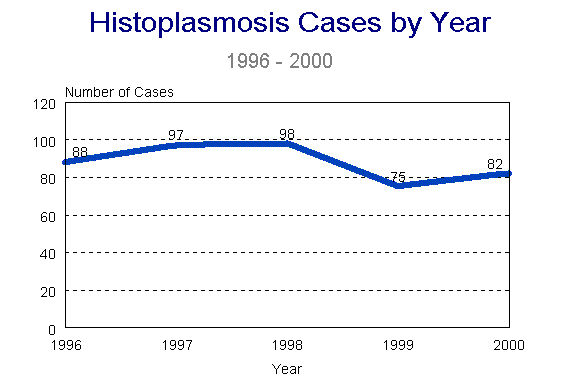Figure Hist1: Histoplasmosis Cases by Year, Indiana, 1996-2000

2000 Indiana Report of Infectious Diseases |
View CDC's Histoplasmosis page
Rates presented are per 100,000 population and are based on the U.S. 2000 Census.
Cases = 82
Crude incidence rate = 1.35 per 100,000 population
Histoplasmosis is caused by the dimorphic fungus Histoplasma capsulatum, which grows as a mold in the soil and as yeast in man and animals. Infection results from inhalation of spores that are disseminated into the atmosphere when soil and/or organic material containing the spores is disturbed. While infection is common, overt clinical disease is not. Individuals with preexisting, immune-compromising conditions are at higher risk of developing clinical disease after exposure. The number of spores inhaled and the host's susceptibility play roles in the development of clinical disease. Clinical disease may vary from a mild respiratory illness to a chronic disseminated disease or a chronic pulmonary disease resembling tuberculosis. Generally, the disease is mild or unrecognized as histoplasmosis; rarely does it develop to a severe progressive disease.
Indiana is part of the eastern and central United States where exposure and infection are prevalent. In 2000, 82 confirmed cases were reported for a crude incidence rate of 1.35 per 100,000 population. Figure Hist1 illustrates the number of cases by year from 1996 through 2000. The annual mean number of reported histoplasmosis cases for that five year period was 88. Figure Hist2 shows the county of residence for cases for 1996-2000.
Histoplasmosis may occur as individual cases or as a local outbreak. Outbreaks have occurred in Indiana when old bird roosting sites have been disturbed during the destruction of buildings or movement of dirt at construction sites. For all age groups, males account for more diagnosed cases of histoplasmosis than females. In the five-year period 1996 to 2000, the overall female to male ratio was 1:2.3 and the ratio for 2000 was 1:2.7. Male clinical infection rates are higher in those ages 20 or more in part because of the immune-suppression caused by HIV infection. In 2000, there were 60 reported cases of histoplasmosis in males. 20 of those cases have been identified as being infected with HIV. One female with HIV was identified among the 20 reported cases of histoplasmosis in females. Additional risk factors for males may be occupational or recreational. From 1996-2000 the incidence rate of histoplasmosis in African Americans was 11.8 per 100,000 population, while the incidence rate in whites was 5.6/100,000. It is not clear at this time if the higher histoplasmosis incidence rate in African Americans is also related to the higher incidence rates of HIV infection in African Americans. Figure Hist3 illustrates the histoplasmosis cases by sex and age for 1996-2000. Figure Hist4 illustrates histoplasmosis cases by sex and age for 2000.
Back to Top of Article
Back to Table of Contents
|
Figure Hist1: Histoplasmosis Cases by Year, Indiana, 1996-2000 |
|
|
Back to Reference in Text
Back to Top of Article
|
Figure Hist2: Counties with Reported Cases of Histoplasmosis, Indiana, 1996-2000 |
|
|
Back to Reference in Text
Back to Top of Article
|
Figure Hist3: Histoplasmosis Cases by Sex and Age Group, Indiana, 1996-2000 |
|
|
Back to Reference in Text
Back to Top of Article
|
Figure Hist4: Histoplasmosis Cases by Sex and Age Group, Indiana, 2000 |
|
|
Back to Reference in Text
Back to Top of Article
Back to Table of Contents
[an error occurred while processing this directive]